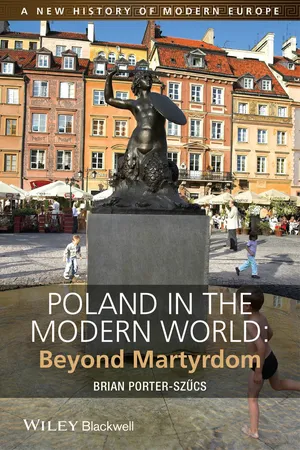
- English
- ePUB (mobile friendly)
- Available on iOS & Android
eBook - ePub
About this book
Poland in the Modern World presents a history of the country from the late nineteenth century to the present, incorporating new perspectives from social and cultural history and positioning it in a broad global context
- Challenges traditional accounts Poland that tend to focus on national, political history, emphasizing the country's 'exceptionalism'.
- Presents a lively, multi-dimensional story, balancing coverage of high politics with discussion of social, cultural and economic changes, and their effects on individuals' daily lives.
- Explores both the regional diversity within Poland and the country's place within Europe and the wider world.
- Provides a new interpretive framework for understanding key historical events in Poland's modern history, including the experiences of World War II and the postwar communist era.
Frequently asked questions
Yes, you can cancel anytime from the Subscription tab in your account settings on the Perlego website. Your subscription will stay active until the end of your current billing period. Learn how to cancel your subscription.
No, books cannot be downloaded as external files, such as PDFs, for use outside of Perlego. However, you can download books within the Perlego app for offline reading on mobile or tablet. Learn more here.
Perlego offers two plans: Essential and Complete
- Essential is ideal for learners and professionals who enjoy exploring a wide range of subjects. Access the Essential Library with 800,000+ trusted titles and best-sellers across business, personal growth, and the humanities. Includes unlimited reading time and Standard Read Aloud voice.
- Complete: Perfect for advanced learners and researchers needing full, unrestricted access. Unlock 1.4M+ books across hundreds of subjects, including academic and specialized titles. The Complete Plan also includes advanced features like Premium Read Aloud and Research Assistant.
We are an online textbook subscription service, where you can get access to an entire online library for less than the price of a single book per month. With over 1 million books across 1000+ topics, we’ve got you covered! Learn more here.
Look out for the read-aloud symbol on your next book to see if you can listen to it. The read-aloud tool reads text aloud for you, highlighting the text as it is being read. You can pause it, speed it up and slow it down. Learn more here.
Yes! You can use the Perlego app on both iOS or Android devices to read anytime, anywhere — even offline. Perfect for commutes or when you’re on the go.
Please note we cannot support devices running on iOS 13 and Android 7 or earlier. Learn more about using the app.
Please note we cannot support devices running on iOS 13 and Android 7 or earlier. Learn more about using the app.
Yes, you can access Poland in the Modern World by Brian Porter-Szücs in PDF and/or ePUB format, as well as other popular books in History & Eastern European History. We have over one million books available in our catalogue for you to explore.
Information
1
POLES WITHOUT POLAND, 1795–1918
There was no Poland on the map between 1795 and 1918. That sentence might seem like a simple historical fact, but it actually raises a whole series of problems that make it really hard to tell the story of 19th century northeastern Europe.
The first date – 1795 – was when Russia, Prussia, and Austria signed a treaty that destroyed the Polish–Lithuanian Republic.1 That was the culmination of a long process of decline, but it was nonetheless a shocking event at the time. In the 18th century it was routine for the elites of one country to meddle in the internal affairs of another. For example, in 1740–48 the European powers fought a major war over the succession to the throne in the Austrian Empire, and it seemed self-evident to most diplomats at the time that the warring parties had been justified in getting involved. The Polish–Lithuanian Republic had been the object of that sort of interference for a long time. In 1733–38 the so-called War of Polish Succession pit France and Spain against Russia, Austria, Saxony, and Prussia, with each coalition fighting to place a different candidate on the Polish throne. So the principle of non-interference was non-existent. Nonetheless, that sort of intrusion was taken to a whole new level in 1772, when Poland’s three neighbors simply annexed wide swaths of the country in what came to be known as the First Partition (Figure 1.1a, Figure 1.1.b). The background to that startling act of plunder need not detain us here; suffice it to say that it was primarily the result of maneuvering by diplomats in Petersburg, Berlin, and Vienna. Poland itself was merely the board on which they were playing their game of Great Power politics.
Figure 1.1 Partitions of Poland, 1772–1795: (a) The Polish–Lithuanian Republic in 1772; (b) The Polish–Lithuanian Republic after the First Partition (1772); (c) The Polish–Lithuanian Republic after the Second Partition (1793); (d) The Polish–Lithuanian Republic after the Third Partition (1795).

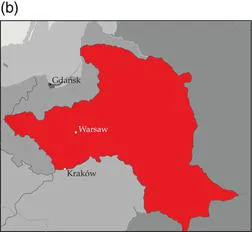
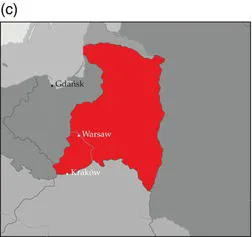
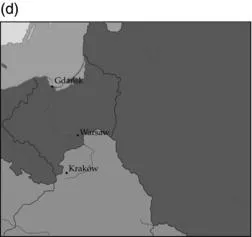
Responding to this humiliation, a reform movement in Poland began pushing for political changes that would strengthen the country against further aggression. Their efforts culminated in a new constitution on May 3, 1791 – a date that is a major national holiday today. The specific provisions of this document were less important in the long run than the rhetoric used to explain and justify them. Slogans like “justice,” “independence,” “fatherland,” “nation,” and above all “freedom” evoked the ideals of the Enlightenment. The very act of writing a binding constitution implied that the law stood above any particular ruler, and not vice versa. Such liberal democratic theories were abhorrent to much of the political elite in Europe at the time, particularly in Russia and Prussia. After the American Revolution of 1776 and the French Revolution of 1789, conservatives were committed to stopping the virus of revolt wherever it appeared. The May 3 Constitution was a provocation to them, and they responded accordingly: in 1793 Poland was partitioned a second time (Figure 1.1c), leaving only a small rump of a country. In response, a reform-minded military hero named Tadeusz Kościuszko (who had earlier fought in the American Revolution, earning the rank of general in Washington’s army) launched a desperate rebellion. The unsurprising retribution was the Third Partition, in 1795 (Figure 1.1d). Poland–Lithuania was no more.
Without an independent state, what is “Polish history” supposed to describe? Many authors have focused on the political and military struggle to regain independence, on the assumption that with the Republic gone, the fight to get it back must necessarily be the main topic of Polish history. That effort was ultimately successful, but there were lots of defeats along the way. There were two major rebellions in the Russian-occupied territories in 1830 and 1863, each leading to crackdowns that only made the situation worse. There were also several smaller armed revolts and countless aborted conspiracies in all three partitions, none of which brought independence any nearer but all of which created heroes and legends that could serve as inspirations for later generations of national activists. An archetype emerged: the valiant freedom-fighter who would risk anything, even death (particularly death), for the sake of the nation. This figure was a tragic hero in the classic sense: a person whose virtue was tied up with a fatal flaw that would always lead to defeat. Poland itself became such a hero, with novelists, poets, and historians telling the story of the nation as if it were a collective agent fighting for its existence, only to fail, inevitably but gallantly, each time. Its virtue was a love of freedom and a courageous willingness to fight for it; its fatal flaw was the tendency to do so regardless of the chance of success.
Corresponding to the heroic but tragic freedom-fighter was another model that resonates to this day in Poland, the so-called Matka-Polka (Mother-Pole). This figure provided a model of national femininity to support the masculine ideal of the insurgent. The Matka-Polka was also defined by sacrifice: that of the wife who willingly accepts her husband’s departure and death for the national cause, and who raises children who are prepared to give their lives in the same way. She is stoic and rather joyless, a beacon of moral rectitude for her warrior-husband. In many ways the Matka-Polka is a variation on familiar 19th century bourgeois norms of femininity (see Figure 1.2). Throughout Europe at the time women of means were told that their purpose was twofold: to raise children and to embody morality for their husbands. As industrial capitalism was replacing older ethical values with norms better suited to a cut-throat business world, women were often held up as the only thing standing between modernity and perdition. In Poland as in France or Britain, this ideal of femininity was narrowly limited to those wealthy enough to sustain a family on just a man’s income (an unattainable luxury for industrial laborers). In Poland this economic stratum was, until the very end of the 19th century, limited to the hereditary nobility – precisely those who were most likely to be drawn to the national movement. Thus the Matka-Polka offered a local twist on the familiar elite feminine norm by giving her the added duty of sustaining not just morality and social order, but the nation as well.
The problem with these archetypes was that many (perhaps even most) people in the lands of the former Polish–Lithuanian Republic refused to take part in this fight. It wasn’t really Poland (in the abstract) that fought for independence, but a specific subset of the population. This brings us to one of the most important but most challenging aspects of Polish history: the meaning and scope of the very word “Poland.” Not all the people living in the lands of the Polish–Lithuanian Republic always called themselves Polish or were recognized as Polish by others, but exactly how that adjective should be defined has been a topic of heated debate for more than two centuries. One approach has been to focus on those who spoke Polish and/or self-identified as Poles. That seems appealing at first glance, but in fact it leads to a lot of problems. For example, during the 19th and early 20th century around a third of the people living in Warsaw spoke Yiddish as their primary language, and this figure was even higher in many smaller towns and cities. In the eastern parts of the former Republic only a small minority spoke Polish, with Ukrainian, Belarusian, and Lithuanian dominating. The largest and richest city of the Republic was known by its German-speaking majority as Danzig, though many of the peasants living outside the city spoke Polish (or a closely related language called Kashubian) and called it Gdańsk. Should we relegate all these non-Polish speakers to the tangential category of “ethnic minorities,” best discussed in separate books? That would be misleading, because we can’t make any sense of Polish history unless we place diversity front-and-center. A history of Poland that failed to fully consider Jews and Ukrainians would be as flawed as a history of the United States that dealt exclusively with white English-speaking Protestants.
Figure 1.2 Portrayals of 19th century ideals of masculinity and femininity. (a) Artur Grottger, Bitwa (The Battle), 1863, reproduced by permission of the Museum of Fine Arts, Budapest; (b) Pożegnanie i powitanie (Farewell and Welcome), 1865–66, courtesy of the Polish National Museum in Kraków.
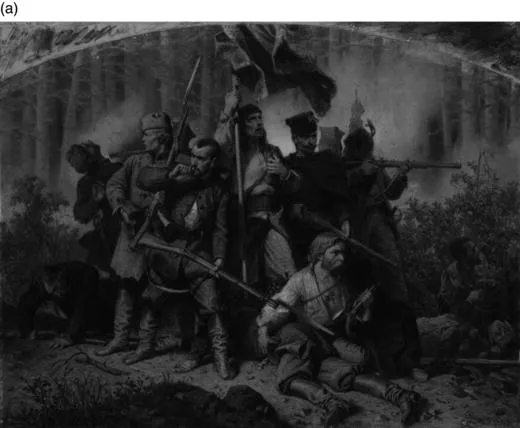
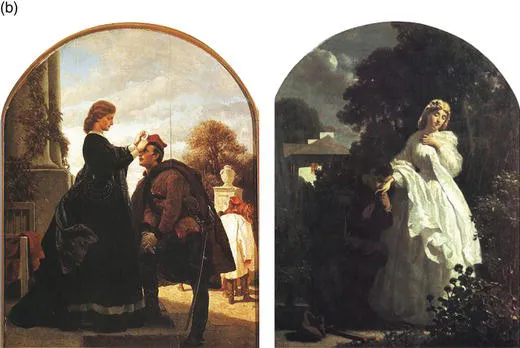
We must never forget that the country destroyed by the partitions had been called the Polish–Lithuanian Republic, not simply Poland. In other words, it was an amalgamation of two separate polities, not a homogeneous nation-state. In 1386 Queen Jadwiga of Poland married Grand Duke Jogaila (Jagiełło) of Lithuania, and their heirs ruled both countries for almost two centuries. During that time the elites of Lithuania gradually drew closer to their Polish counterparts, and by 1569 the bonds were close enough to enable the transformation of this dynastic alliance into a united Polish–Lithuanian state. Cultural homogenization, however, came very slowly: Polish was made the official language of governance for the whole Republic only in 1699, and although Roman Catholicism was dominant by the late 17th century, many Eastern Rite Catholic (and some Protestant) nobles remained. In this context “Lithuania” was the name of a large administrative region with its own separate laws and customs, but the landowning nobles who lived there participated fully in Polish politics and culture. The word “Poland” was therefore used to refer to a specific territory within the Republic (the part that had been the medieval Kingdom of Poland), but people often casually used the term to describe the entire country (thus “the War for Polish Succession” or “The Partitions of Poland”).
This slippery nomenclature allows us to make sense of Adam Mickiewicz (1798–1855), who is to Poles what William Shakespeare is to Anglophones. Schoolchildren still have to memorize his poems, and his plays have been made into countless films – most recently in 1999, when the famous director Andrzej Wajda released a much-praised rendition of Mickiewicz’s masterpiece, Pan Tadeusz. That particular Polish-language work is noteworthy because of its opening lines:
Lithuania, my Fatherland
You are like health.
Only those who have lost you
can fully appreciate you.”2
You are like health.
Only those who have lost you
can fully appreciate you.”2
In other words, the most famous Polish poet began his most famous work with a homage to his homeland: Lithuania. There is, appropriately enough, a statue to Adomas Mickevičius in Vilnius, the capital of Lithuania. But that’s not all: Mickiewicz’s birthplace was in the village of Zaosie, which is located in what is today Belarus. That country put the image of a young Адам Міцкевіч on a national stamp in 1998 to commemorate the bicentenary of his birth. So is Mickiewicz Polish, Lithuanian, or Belarusian? Well, he was all of the above and none of the above. All of the above, insofar as Mickiewicz did not see these labels as mutually exclusive. None of the above, insofar as those terms meant something for him that bears little relation to what they mean to us.
Sometimes the Polish–Lithuanian Republic is characterized as a haven of ethnic tolerance and cohabitation, and while that claim is not necessarily false, it can be misleading. On the one hand, the Republic was probably the most religiously and linguistically diverse place in Europe. We don’t have exact numbers, but best estimates are that by the 18th century about half the population was Western Rite (Roman) Catholic, and another third was Eastern Rite Catholic. The latter group was created in the late 16th century in a failed attempt to reunite the Eastern (Orthodox) and Western (Catholic) branches of Christianity. On matters of ritual and tradition the Eastern Rite Catholics retain Orthodox practices, but they acknowledge the authority of the pope in Rome. Just to make matters more confusing, they are sometimes called “Uniates” or “Greek Catholics.” About 7 percent of the population of the Polish–Lithuanian Republic was Jewish, and the Protestants and Eastern Orthodox were at about 5 percent each.3 Language and religion did not precisely overlap, but in very broad terms the Roman Catholics mostly spoke Polish or Lithuanian, the Eastern Rite Catholics mostly spoke Ukrainian, the Eastern Orthodox mostly spoke Russian or Belarusian, the Protestants mostly spoke German, and the Jews mostly spoke a language that would later come to be known as Yiddish. That said, it would be a huge mistake to transpose our modern ethno-national categories (Pole, Ukrainian, Russian, Belarusian, Jew, German), back onto the inhabitants of the Republic. If we want to understand those people in their own terms, we have to accept that in their world, social status and function mattered more than language or even religion.
At the top of that social world was the szlachta (nobility), which made up around 8–9 percent of the population in the late 18th century. The adult males among them had a virtual lock on political and economic power. The right to own land was limited to the szlachta and the Church, and the military was dominated by men of noble birth. Nearly all the members of this caste spoke Polish as their primary language, and nearly all were Roman Catholics – but their family lineage, rather than language or religion, constituted the focal point of their identity. Moving down the social hierarchy, about 6 percent of the population were townsmen, and another 0.5 percent were members of the clergy. Each of these groups had its own internal self-governance, its own system of courts, and its own distinct laws. The 6–9 percent of the population that was Jewish was also set apart, and their autonomy was in accordance with the overall decentralized structure of the state. For the most part, as long as the Jewish communities of Poland paid their taxes they could manage their own internal affairs, just as the nobles, the townsmen, and the clergy could. There were other (much smaller) groups as well: Armenians, Muslim Tatars, Dutch and Scottish religious dissidents, and more.
Finally there were the peasants, making up almost three quarters of the population. Unlike the nobles, the townsmen, the clergy, or the Jews, the peasants had virtually no self-governance. They were serfs, subject to the will of the landowners. Serfdom was not quite the same thing as slavery, because they could not...
Table of contents
- Cover
- A NEW HISTORY OF MODERN EUROPE
- TITLE PAGE
- COPYRIGHT PAGE
- LIST OF FIGURES
- ACKNOWLEDGMENTS
- PRONUNCIATION GUIDE
- INTRODUCTION
- 1 POLES WITHOUT POLAND, 1795–1918
- 2 THE POLITICAL LANDSCAPE AT THE START OF THE 20TH CENTURY
- 3 NATION AND/OR REVOLUTION, 1914–22
- 4 THE AMBIVALENCE OF DEMOCRACY AND AUTHORITY, 1922–39
- 5 HYPERINFLATION AND DEPRESSION: THE INTERWAR PERIOD
- 6 JEWS, UKRAINIANS, AND OTHER POLES IN THE INTERWAR PERIOD
- 7 WORLD WAR II, 1939–45
- 8 CONQUEST OR REVOLUTION? 1945–56
- 9 THE YEAR 1956 AND THE RISE OF NATIONAL COMMUNISM
- 10 COMMUNISM AND CONSUMERISM
- 11 THE END OF THE PRL, 1976–89
- 12 SHOCK THERAPY
- 13 POLITICS IN THE THIRD REPUBLIC
- INDEX